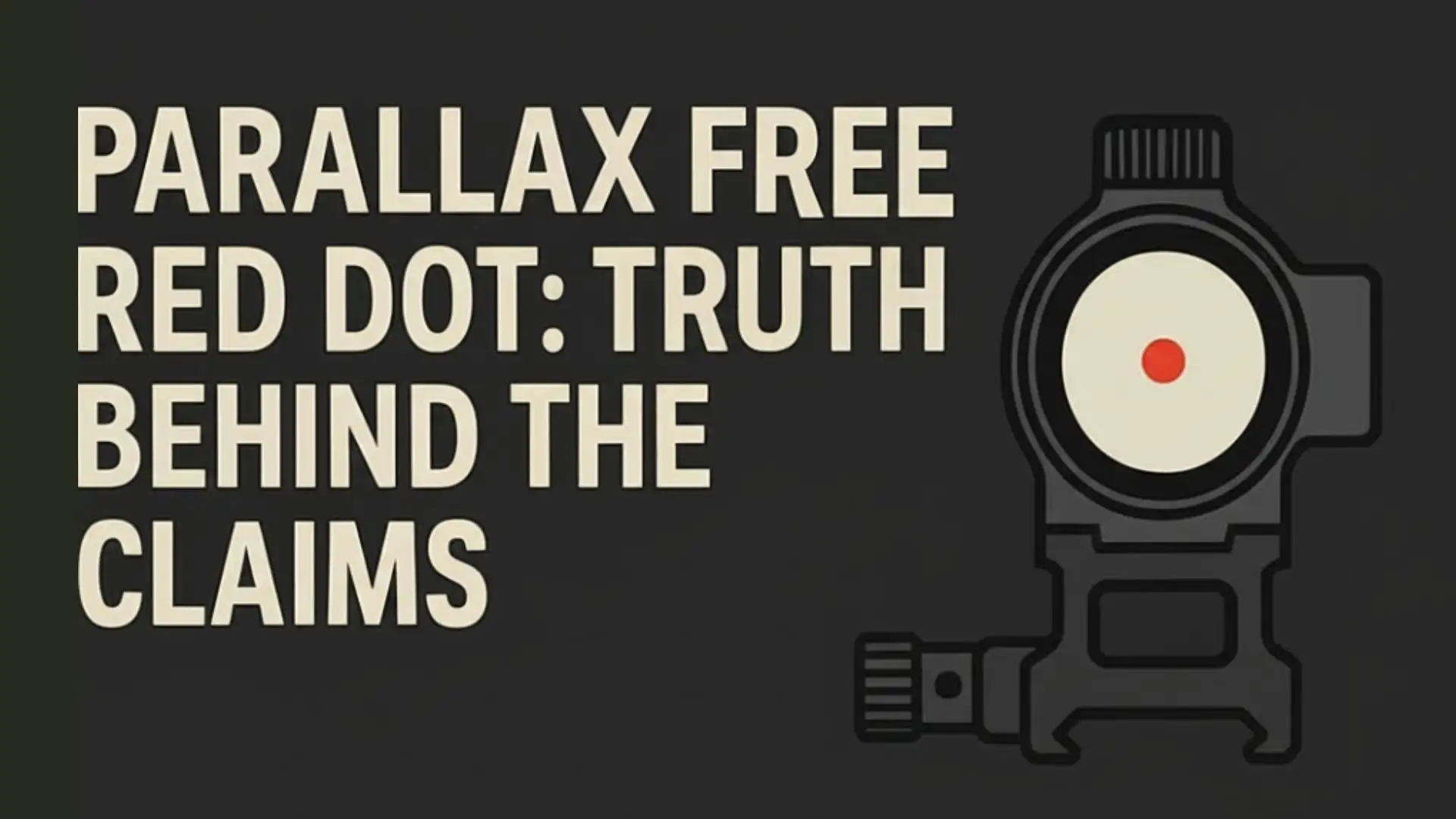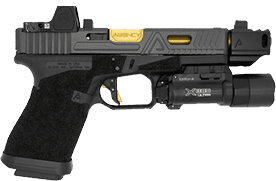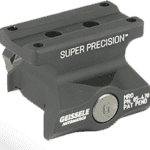Parallax Free Red Dot: Truth Behind the Claims & Best Options
Published on: August 30, 2025

Reading time: 8 mins 56 secs
Independent testing reveals that popular “parallax-free” red dots actually exhibit parallax errors, contrary to some manufacturers’ claims. This disconnect between marketing promises and measurable performance has left shooters making critical equipment decisions based on misleading specifications rather than actual data.
When your accuracy depends on reliable equipment, understanding these performance realities becomes essential for making informed purchasing decisions.
This comprehensive analysis cuts through the marketing noise with evidence-based testing data, honest manufacturer assessments, and practical recommendations that help you choose red dot sights based on actual performance rather than advertising claims.
Highlights
- Parallax-free means the red dot stays on target even if your eye shifts position.
- Most red dot sights marketed as “parallax-free” still exhibit measurable parallax errors.
- Independent testing shows that even premium optics vary widely in real-world parallax performance.
- LED and holographic systems both struggle with parallax.
- Price doesn’t always predict performance—some budget optics match or outperform expensive ones.
What is Parallax Free Red Dot?
Parallax-free is when your eye moves off the red dot of your sight, the apparent position of that dot shouldn’t move away from the target.
Parallax occurs when the reticle appears to move relative to your target as your eye position shifts behind the optic. This fundamental optical phenomenon affects all red dot sights due to the physics of collimated light systems, making manufacturer claims of “zero parallax” technically impossible.
The most honest manufacturers acknowledge this limitation through terminology like “operationally parallax free,” recognizing that while perfect elimination isn’t achievable, quality engineering can minimize parallax to acceptable levels for practical applications.
The Physics Behind Parallax Errors
Collimated optical systems can only achieve true parallax-free performance at optical infinity, with measurable error circles at any finite distance. Quality manufacturers set their collimation distance around 50-100 yards to optimize performance at common engagement ranges.
Manufacturing precision directly impacts parallax performance. Industry standards typically allow ±2 MOA deviation in standard red dots, while premium optics achieve ±1 MOA tolerances through advanced manufacturing processes and quality control systems.
Environmental factors compound these baseline tolerances. Temperature difference can add some MOA of parallax error. Users also observed this phenomenon.
Industry Marketing vs. Measured Performance
The disconnect between manufacturer claims and independent testing results reveals a systematic pattern of overstated performance specifications. While most brands tout “parallax-free” operation, comprehensive independent testing demonstrates significant variation between claimed and actual performance.
Aimpoint stands out for honest terminology, consistently using “operationally parallax-free” in their technical documentation. This acknowledges practical limitations while setting realistic user expectations about achievable performance levels.
Most competitors continue using absolute claims that independent testing contradicts, creating unrealistic expectations among users who expect perfect performance that current optical technology can’t deliver consistently.
Technology Comparison: How Different Systems Handle Parallax
LED-Based Red Dot Sight
Traditional LED red dots dominate the market through cost-effectiveness and simplicity, but performance varies dramatically based on optical design quality. Premium models from established manufacturers typically achieve sub-2 MOA performance, while budget alternatives may exceed 10 MOA deviation under testing conditions.
The LED projection system creates inherent challenges for parallax control. Manufacturers must balance dot brightness, battery efficiency, and optical precision, often requiring compromises that affect parallax performance in real-world conditions.
Advanced LED systems incorporate multi-element optics and precision-manufactured reflective surfaces to minimize parallax errors, though they can’t eliminate the fundamental physics limitations of collimated light projection.
Holographic Red Dot Sight
Holographic sights utilize laser interference patterns projected onto specialized film substrates, theoretically and supposedly offering advantages over LED systems. However, it was tested that it almost produced the same parallax error.
Comprehensive evaluation reveals holographic sights typically achieve 3-5 MOA parallax error—competitive with quality LED systems rather than dramatically superior as often claimed. This performance similarity challenges industry assumptions about the advantages of holographic technology.
The complex reticle capabilities of holographic systems provide tactical advantages in specific applications, but parallax performance doesn’t justify the significant price premium over well-designed LED alternatives for most users.
Enclosed Emitter Innovations
New red dot sights with enclosed emitters have a sealed design that keeps out dust, rain, and dirt. This makes them more durable and reliable in rough conditions. However, just because the LED is protected doesn’t mean these optics are automatically better at controlling parallax.
Thanks to better manufacturing, some enclosed sights have more consistent alignment, which can make the dot appear more stable. But the basic limits of red dot design haven’t changed—you might see a small improvement, but don’t expect perfect aim from every angle. The real benefits are in weather protection and longer-lasting performance, not major optical upgrades.
Independent Testing Results: Data-Driven Reality
Comprehensive Performance Analysis
Eric Dorenbush provides the most comprehensive comparative study of red dot sight parallax, using standardized methodologies and volunteer testers to eliminate manufacturer bias from evaluation processes.
Testing methodology included controlled environments, standardized distances, and multiple test subjects to ensure repeatable results. This scientific approach reveals significant discrepancies between manufacturer specifications and measurable performance across multiple brands and price points.
The data demonstrates that price doesn’t guarantee superior parallax performance, with some expensive models showing worse results than budget alternatives, challenging conventional assumptions about quality correlating with cost.
Specific Model Performance Data
The Trijicon MRO, despite premium pricing and “PARALLAX-FREE” marketing claims, demonstrated 13.4 MOA average deviation across all testing distances. This performance contradicts manufacturer specifications and user expectations based on marketing materials.
Aimpoint T-1 results showed 9.7 MOA average deviation, despite being marketed as a “parallax-free optic.” These results highlight the gap between marketing terminology and measurable performance, even from respected manufacturers.
EOTech EXPS models achieved superior results at 1.7 MOA average deviation, demonstrating that some manufacturers can achieve significantly better real-world performance. Notably, EOTech provides more honest specifications, acknowledging up to 14 MOA error across their viewing window rather than claiming perfect performance.
Real-World Impact Assessment
Understanding these numbers in practical terms helps contextualize their significance for different shooting applications. A 10 MOA parallax error equals 10 inches of potential miss at 100 yards, or 2.5 inches at 25-yard defensive distances.
For close-quarters defensive scenarios, higher parallax tolerance remains acceptable given larger target zones and shorter engagement distances. However, precision shooting, competition work, or hunting applications demand minimal parallax for consistent accuracy requirements.
Environmental factors can influence optical performance. Extreme temperatures may affect lens alignment or emitter stability, potentially increasing parallax error.
Best Parallax-Free Red Dot Options by Category
As discussed throughout this blog, no red dot sight is completely parallax-free. However, for clarity and comparison, we’ll refer to optics with minimal practical parallax as “parallax-free” here.
These recommendations are based on independent testing, manufacturer transparency, and real-world performance—not marketing claims.
Premium Performance Tier ($500+)
Aimpoint CompM5 & PRO Series
Aimpoint sets realistic expectations with its “operationally parallax-free” labeling. Independent testing shows respectable sub-10 MOA deviation under varied conditions, and Aimpoint’s reputation for battlefield durability makes these optics a go-to for professional use.
EOTech EXPS Series
EOTech holographic sights like the EOTech EXPS2 have tested not really better than most LED competitors parallax-wise, but their large window and honest disclosure of potential parallax shift (up to 14 MOA across the viewing area) make them a standout for transparency and performance. The 68 MOA ring + 1 MOA dot reticle also improves speed and precision at varied distances.
Value-Oriented Performance ($200-500)
Holosun 510C Series
A top performer in the value tier, the 510C features a wide window, multiple reticle options, solar backup, and competitive parallax characteristics. While not tested in the same lab-controlled studies as premium brands, it has earned strong reviews from users and reviewers alike for optical consistency.
Sig Sauer ROMEO5
The Sig Romeo 5 is a reliable, no-frills red dot with acceptable parallax control in practical use. Though not laboratory-proven to outperform premium optics, its robust construction, 50,000-hour battery life, and motion-activated illumination make it a favorite in this price bracket.
Primary Arms SLx Red Dots
Known for their value engineering and ACSS reticles, SLx models offer acceptable parallax performance for their class. The etched reticle backup is especially helpful when using magnifiers or in battery-failure scenarios.
Budget-Conscious Options (Under $200)
Budget optics often trade optical precision for affordability. While usable for recreational shooting, many of these models exhibit noticeable parallax error, especially at closer ranges or when used with inconsistent head positioning.
These red dots are best for plinking, training, or non-critical applications where exact point-of-aim isn’t essential. Brands like Bushnell TRS-25 or Monstrum can perform well within their limitations, but users should not expect premium-grade optical alignment.
Practical Testing and Evaluation Methods
DIY Parallax Assessment
You can evaluate parallax performance using systematic testing methods adapted from professional evaluation protocols. Set up a precise target at 25 yards with a small aiming point, then deliberately shift your head position to the viewing window extremes while maintaining sight picture.
From CUDA Optics
Document dot movement relative to the target as you change eye position. Quality optics should demonstrate minimal movement (under 2 MOA), while poor performers will show obvious dot wandering across the target face that affects practical accuracy.
Compare your results to manufacturer specifications to identify discrepancies between claimed and actual performance. Many users discover their “parallax-free” optics show significant deviation, especially when testing at viewing window extremes rather than perfect center alignment.
Professional Testing Standards
Professional evaluation requires controlled conditions with standardized equipment and multiple test subjects to eliminate individual variation. The most comprehensive independent testing mentioned in this blog provides a template methodology for systematic evaluation using scientific principles.
Installation and Optimization Strategies
Mounting System Considerations
Proper mounting height doesn’t change an optic’s internal parallax, but it does affect how often you’re likely to see off-center errors. A height that aligns naturally with your shooting stance helps reduce reticle shift caused by misaligned eye position.
Co-witness configurations also affect user perception. Absolute co-witness places your iron sights directly in line with the dot, while lower 1/3 co-witness keeps them out of the main field of view, helping reduce clutter and eye confusion.
Use manufacturer torque specs—usually 15–25 inch-pounds—for mounting screws. Under or over-tightening can allow the optic to shift under recoil, creating false parallax-like symptoms. Always use a torque driver.
Troubleshooting Performance Issues
If the red dot seems to move, don’t assume it’s parallax right away. Loose mounts, inconsistent cheek weld, or even poor-quality risers can create similar symptoms. Start with a hardware and technique check.
If there’s excessive reticle shift at close range or inconsistent performance, document it. Manufacturers may replace defective units, especially if emitter misalignment or lens defects are present.
Application-Specific Performance Requirements
Tactical and Defensive Applications
In close-quarters defensive use, higher parallax is generally acceptable. At typical engagement distances, targets are large, and fast response matters more than pinpoint accuracy. Most quality red dots perform well enough under these conditions.
High-stress scenarios make perfect sight alignment difficult. Red dots with minimal parallax help maintain effective accuracy even when the head position isn’t ideal. For this reason, many professionals consider the added cost of premium optics worthwhile.
Military and law enforcement agencies often test optics in extreme environments. These procurement processes ensure that selected models meet strict durability and reliability standards, including resistance to parallax error under varied conditions.
Competition and Precision Requirements
Precision shooting—whether in long-range rifle matches or bullseye pistol events—requires optics with very low parallax to avoid score-robbing deviations. Even slight reticle shifts can cause point-of-impact changes at extended distances.
Speed-based sports like USPSA or 3-Gun often prioritize target acquisition speed over perfect accuracy. Some shooters choose optics with slightly more parallax if it means faster transitions and easier tracking, accepting minor trade-offs in precision.
Competition rules often limit optic type, size, or features. Understanding those limitations allows competitors to select models that offer the best mix of speed, accuracy, and parallax control within the allowed equipment categories.
Hunting and Field Applications
Hunting optics must match the game and environment. Big game hunting at closer distances may allow for some parallax error, but varmint or predator hunting often demands tight accuracy—making parallax control more important.
Field conditions like extreme temperatures, fog, or rain can affect optic clarity and performance. Durable, sealed optics are essential for maintaining function and consistency in unpredictable environments.
Ethical hunting depends on reliable shot placement. Knowing your optic’s parallax limitations helps you judge when a shot is within your equipment’s reliable range—reducing the risk of wounding animals due to sight misalignment.
Technology Trends and Future Developments
Manufacturing Precision Advances
Modern optics manufacturing has improved significantly, with tighter tolerances and better emitter alignment reducing parallax inconsistencies across production units. High-end red dot sights now undergo more rigorous quality control, helping ensure consistent optical performance and reliability.
While some manufacturers still use vague “parallax-free” marketing, the industry is slowly shifting toward more transparent specifications. Brands that share measurable parallax data—rather than broad claims—are gaining consumer trust and setting more realistic expectations.
Although experimental research in computational optics and metasurface lens design shows promise for future innovations, active parallax correction systems are not yet available in commercial red dot sights. These concepts remain in early academic or prototype stages.
Integration With Advanced Systems
Optics are increasingly designed for seamless use with magnifiers, night vision, and thermal devices. Newer models maintain parallax performance better when paired with accessories, which is critical for operational versatility in both tactical and hunting setups.
Looking ahead, “smart” optics with embedded sensors or processors may eventually offer real-time aim correction or environmental adaptation. While no such consumer-ready systems exist today, early research in this field suggests the potential for these features in the coming years.
Conclusion
The reality of red dot sight parallax performance differs substantially from manufacturer marketing claims, with independent testing revealing significant variations between models and brands across all price categories. Understanding these performance differences enables informed decisions based on actual capabilities rather than advertising promises that may not reflect real-world results.
While perfect parallax elimination remains technically impossible, quality optics achieve “operationally parallax-free” performance suitable for most shooting applications. Success lies in choosing products with honest specifications and proven performance rather than those making unrealistic claims about optical perfection that physics cannot deliver.
If you’re looking for other red dot sights aside from the ones mentioned above, Gold Trigger has a selection you can choose from. You may also call us at (713) 485-5773.
Disclaimer: The information provided in this parallax-free red dot guide is for educational purposes only and should not be considered professional advice. While we strive to present accurate and up-to-date information based on independent testing and manufacturer specifications, individual red dot performance may vary based on specific mounting systems, environmental conditions, and user technique, among others.
Always follow local, state, and federal laws regarding firearm modifications and optic installations. Proper training and familiarity with your equipment are essential for safe operation. Gold Trigger recommends consulting with qualified professionals for installation and setup when in doubt.
The use of firearms and related accessories carries inherent risks, and users assume full responsibility for safe handling and operation. This guide does not replace manufacturer instructions, professional training, or proper safety protocols. Performance testing results referenced in this article are based on available independent studies and may not reflect current production models.
Parallax performance can be affected by manufacturing tolerances, environmental conditions, and proper installation. Gold Trigger is not responsible for any performance issues resulting from improper installation, use, or maintenance of red dot sights. Always verify current specifications and warranty terms with manufacturers before purchase.
Prices and availability mentioned in this guide are subject to change and may vary by location and retailer. Product recommendations are based on available performance data and should be verified through personal testing when possible.





Comments